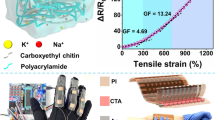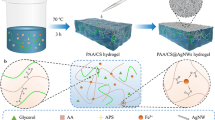Abstract
In recent years, conductive hydrogels have become a promising candidate for application in fields such as tissue engineering and flexible electronic devices because of their conductivity, soft and wet nature. However, the preparation of tough and uniformly conductive hydrogels remains challenging because conductive nanofillers tend to aggregate during hydrogel formation. Herein, a hydrophilic polymer assistant dispersion strategy is proposed to fabricate a tough, conductive composite hydrogel with double-network based on well-dispersed carbon nanotubes (CNTs). In particular, A@T2.0/polyacrylamide (PAM) hydrogels showed a tensile strength of 332.9 kPa, elongation of 584.6%, Young’s modulus of 91.5 kPa, and conductivity of 2.765 S m−1, and a demonstration was performed to show the strain sensing for health monitoring and handwriting. Results showed that the fabricated conductive hydrogels offer promising and broad insights in the field of wearable sensors for health monitoring, innovative electronics, and human machine interactions.
Similar content being viewed by others
References
Sasaki M, Karikkineth B C, Nagamine K, et al. Highly conductive stretchable and biocompatible electrode-hydrogel hybrids for advanced tissue engineering. Adv Healthcare Mater, 2014, 3: 1919–1927
Lin F C, Zheng R T, Chen J W, et al. Microfibrillated cellulose enhancement to mechanical and conductive properties of biocompatible hydrogels. Carbohydrate Polyms, 2019, 205: 244–254
Rong Q F, Lei W W, Liu M J. Conductive hydrogels as smart materials for flexible electronic devices. Chem Eur J, 2018, 24: 16930–16943
Lu J S, Han X, Dai L, et al. Conductive cellulose nanofibrils-reinforced hydrogels with synergetic strength, toughness, self-adhesion, flexibility and adjustable strain responsiveness. Carbohydrate Polyms, 2020, 250: 117010
Xu H P, Shen Z Q, Gu G Y. Performance characterization of ionic-hydrogel based strain sensors. Sci China Tech Sci, 2020, 63: 923–930
Yang W X, Shao B W, Liu T Y, et al. Robust and mechanically and electrically self-healing hydrogel for efficient electromagnetic interference shielding. ACS Appl Mater Interfaces, 2018, 10: 8245–8257
Zhao Y, Chen S, Hu J, et al. Microgel-enhanced double network hydrogel electrode with high conductivity and stability for intrinsically stretchable and flexible all-gel-state supercapacitor. ACS Appl Mater Interfaces, 2018, 10: 19323–19330
Han L, Lu X, Wang M H, et al. A mussel-inspired conductive, self-adhesive, and self-healable tough hydrogel as cell stimulators and implantable bioelectronics. Small, 2017, 13: 1601916
Guan F Y, Han Z L, Jin M T, et al. Durable and flexible bio-assembled rGO-BC/BC bilayer electrodes for pressure sensing. Adv Fiber Mater, 2021, 3: 128–137
Gan D L, Han L, Wang M H, et al. Conductive and tough hydrogels based on biopolymer molecular templates for controlling in situ formation of polypyrrole nanorods. ACS Appl Mater Interfaces, 2018, 10: 36218–36228
Ma L Y, Nie Y, Liu Y R, et al. Preparation of core/shell electrically conductive fibers by efficient coating carbon nanotubes on polyester. Adv Fiber Mater, 2021, 3: 180–191
Han L, Liu K Z, Wang M H, et al. Mussel-inspired adhesive and conductive hydrogel with long-lasting moisture and extreme temperature tolerance. Adv Funct Mater, 2018, 28: 1704195
Pan X F, Wang Q H, He P, et al. A bionic tactile plastic hydrogel-based electronic skin constructed by a nerve-like nanonetwork combining stretchable, compliant, and self-healing properties. Chem Eng J, 2020, 379: 122271
Zhang H, Ren P G, Yang F, et al. Biomimetic epidermal sensors assembled from polydopamine-modified reduced graphene oxide/polyvinyl alcohol hydrogels for the real-time monitoring of human motions. J Mater Chem B, 2020, 8: 10549–10558
Chen T, Wei P L, Chen G Y, et al. Heterogeneous structured tough conductive gel fibres for stable and high-performance wearable strain sensors. J Mater Chem A, 2021, 9: 12265–12275
Ostos F J, Lebrón J A, Moyá M L, et al. Potentiometric study of carbon nanotube/surfactant interactions by ion-selective electrodes. Driving forces in the adsorption and dispersion processes. Int J Mol Sci, 2021, 22: 826
Kuang Y D, Chen C J, Pastel G, et al. Conductive cellulose nanofiber enabled thick electrode for compact and flexible energy storage devices. Adv Energy Mater, 2018, 8: 1802398
Chen G Y, Yu H Y, Zhang C H, et al. A universal route for the simultaneous extraction and functionalization of cellulose nanocrystals from industrial and agricultural celluloses. J Nanopart Res, 2016, 18: 48
Chen G Y, Wang G, Tan X R, et al. Integrated dynamic wet spinning of core-sheath hydrogel fibers for optical-to-brain/tissue communications. Natl Sci Rev, 2021, 8: nwaa209
Yu H Y, Yan C F, Yao J M. Fully biodegradable food packaging materials based on functionalized cellulose nanocrystals/poly(3-hydroxybutyrate-co-3-hydroxyvalerate) nanocomposites. RSC Adv, 2014, 4: 59792–59802
Xu J J, Jin R N, Ren X Y, et al. Cartilage-inspired hydrogel strain sensors with ultrahigh toughness, good self-recovery and stable anti-swelling properties. J Mater Chem A, 2019, 7: 25441–25448
Sun J Y, Zhao X H, Illeperuma W R K, et al. Highly stretchable and tough hydrogels. Nature, 2012, 489: 133–136
Xia S, Song S X, Gao G H. Robust and flexible strain sensors based on dual physically cross-linked double network hydrogels for monitoring human-motion. Chem Eng J, 2018, 354: 817–824
Teng K X, An Q, Chen Y, et al. Recent development of alginate-based materials and their versatile functions in biomedicine, flexible electronics, and environmental uses. ACS Biomater Sci Eng, 2021, 7: 1302–1337
Fan Z W, Duan L J, Gao G H. Self-healing carrageenan-driven polyacrylamide hydrogels for strain sensing. Sci China Tech Sci, 2020, 63: 2677–2686
Lai J L, Zhou H W, Wang M C, et al. Recyclable, stretchable and conductive double network hydrogels towards flexible strain sensors. J Mater Chem C, 2018, 6: 13316–13324
Author information
Authors and Affiliations
Corresponding author
Additional information
This work was supported by the Natural Science Foundation of Shanghai (Grant No. 21ZR1400500), the National Natural Science Foundation of China (Grant Nos. 52173029, 51803022, 51733002), the Fundamental Research Funds for the Central Universities (Grant Nos. 2232021D-05, 2232018A3-01), the Cooperative Project with Bestee (Grant No. 106210232), and the Graduate Student Innovation Fund of Donghua University (Grant No. CUSF-DH-D-2020038).
Supporting Information
The supporting information is available online at tech.scichina.com and link.springer.com. The supporting materials are published as submitted, without typesetting or editing. The responsibility for scientific accuracy and content remains entirely with the authors.
Supporting Information
11431_2021_2000_MOESM1_ESM.pdf
Tough, Conductive Hydrogels with Double-network Based on Hydrophilic Polymer Assistant Well-Dispersed Carbon Nanotube for Innovative Force Sensor
Rights and permissions
About this article
Cite this article
Chen, G., Guo, Y., Hsiao, S.B. et al. Tough, conductive hydrogels with double-network based on hydrophilic polymer assistant well-dispersed carbon nanotube for innovative force sensor. Sci. China Technol. Sci. 65, 1160–1168 (2022). https://doi.org/10.1007/s11431-021-2000-7
Received:
Accepted:
Published:
Issue Date:
DOI: https://doi.org/10.1007/s11431-021-2000-7




